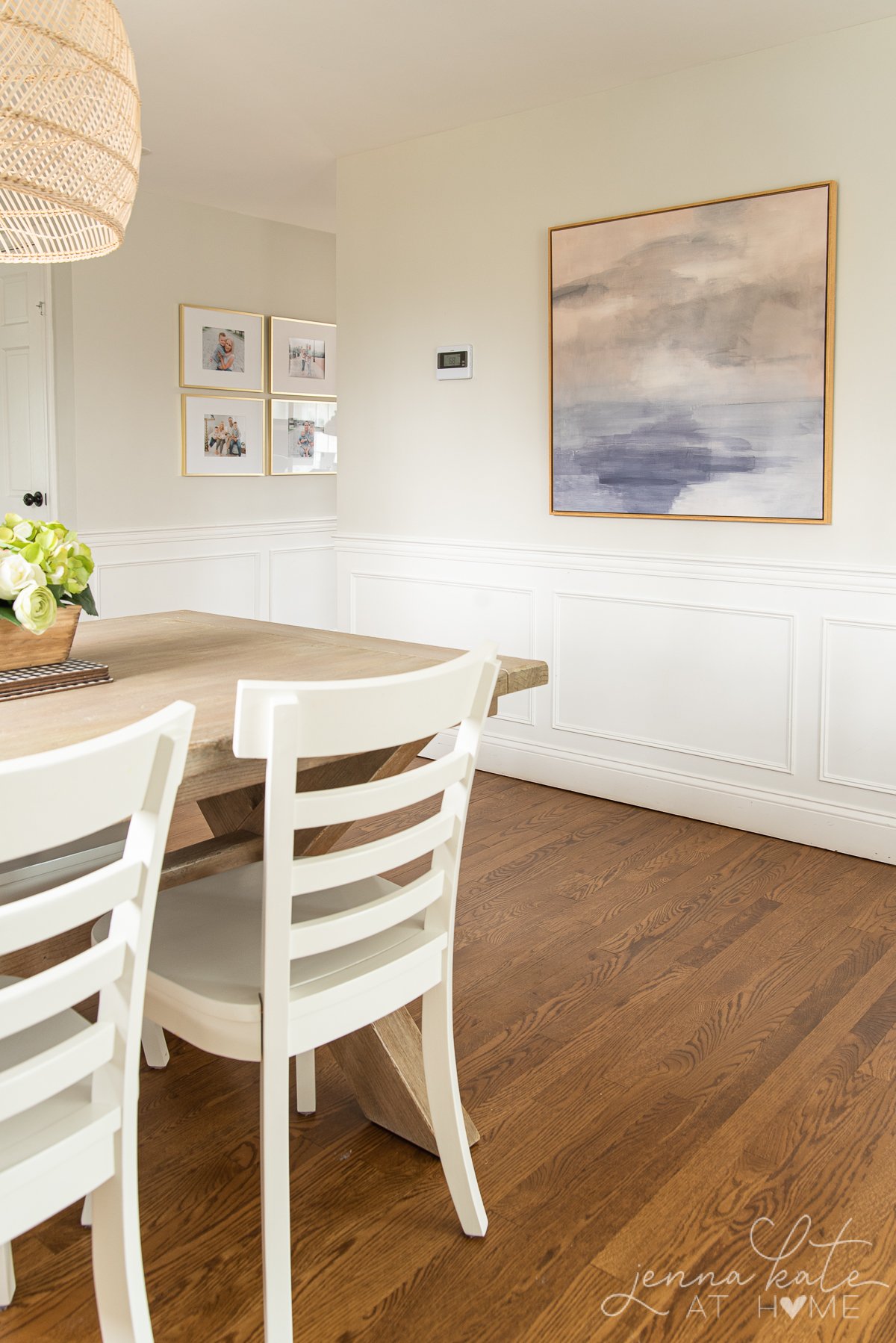Content may contain affiliate links. When you shop the links, I receive a small commission at no cost to you. Thank you for supporting my small business.
Selecting the right paint for your home is a multi-step process that goes beyond picking a color. It involves deciding on the ideal sheen, which can significantly impact the look and functionality of your walls.
While color sets the mood, the sheen determines the finish’s durability, ease of cleaning, and how light interacts with the paint. Eggshell paint, known for its very subtle sheen, emerges as the preferred choice for most interior wall projects.
When and Why to Pick Eggshell Paint
Flat paint hides imperfections, while glossy paint shows everything. But, a glossier sheen is easier to clean than a flat sheen. Eggshell paint, with its very subtle sheen, hits that sweet spot between matte paint and glossier options. It hides imperfections well, while also maintaining the ability to easily wipe down walls if needed.

Good Things About Eggshell Paint
Eggshell paint is favored for high-traffic areas because it’s more durable and easier to clean with just a damp cloth than matte paint, without the high maintenance of high gloss paint.
It’s a great choice for hallways and living spaces, offering a low luster that reflects light gently, enhancing the paint’s color with a very subtle sheen.
Times You Might Not Want Eggshell Paint
While eggshell is a fantastic option for many interior spaces, it’s not the preferred choice for trim, doors and cabinets. For these, I usually choose a higher sheen (either satin or semi-gloss) to set them apart from the soft sheen of the walls.
This is especially important if your walls and trim are the same color (all-white for instance) to offer some contrast.
In these areas, a semi-gloss paint or a higher gloss option is also usually a better choice due to its greater durability. These glossier paints are easier to clean, and more durable to withstand constant touching.
Years ago, eggshell was not advised for high-humidity environments like bathrooms, but today’s paints are of much higher quality and this is no longer an issue.
Eggshell vs. Satin
Choosing between eggshell and satin paint sheens can be tricky. Satin offers a higher gloss, making it a good choice for spaces that need easy cleanup, like kitchens or playrooms. Its satin enamel sheen stands up better to scrubbing, making it a popular choice for those looking for a balance between eggshell’s softness and the durability of glossier paints.
Eggshell vs. Matte
Matte paint, with its flat finish, is excellent at hiding wall imperfections but can be less durable and harder to clean. Eggshell is more forgiving and a better option for those wanting to maintain an elegant interior without the worry of high maintenance.
If you don’t have kids or pets, choose Matte because it gives the most beautiful velvety finish. However, if you have kids or pets, definitely pick the Eggshell. It looks very close to matte but is more durable, doesn’t scuff as easily and can be wiped down.
Eggshell vs. Semi-Gloss
Semi-gloss paint, known for its higher gloss finish is the most popular choice for trim and doors. It has a harder finish than eggshell as well as being more moisture resistant. Satin is also a popular choice for trim, as hides imperfections in the wood better. If you have kids and pets, semi-gloss is a better option.

Is Eggshell the Same Level of Sheen Amongst All Paint Brands?
No, the level of luster will not look exactly the same between paint brands. Most paint manufacturers call their medium sheen Eggshell. Sherwin Williams’s Eggshell sheen is less shiny than Benjamin Moore’s. Plus, some Sherwin-Williams’ higher paint grades such as Duration and Emerald don’t offer an eggshell sheen – in those instances, use a matte sheen.
FAQ’s
Absolutely, eggshell paint is a great option for nearly any room, offering a balance of durability and ease of cleaning that’s hard to beat. Whether you’re looking for the perfect color for your dining room or a high-quality finish for your living spaces, eggshell is a versatile choice that works well in both bright and darker colors.
Yes, touching up eggshell paint is relatively easy, especially if you use high-quality paint supplies. A damp cloth can often remove mildew stains or scuffs, and for bigger touch-ups, a little paint can blend seamlessly into the existing finish.
Eggshell paint is good at hiding small blemishes thanks to its low luster, making it a better choice than high-gloss paint for walls with minor imperfections. It’s a smart way to achieve a clean, inviting look in your home without the need for frequent touch-ups.
Eggshell paint can be used on exterior surfaces, though it’s less common. Exterior paint typically has a glossier finish to withstand weather conditions and facilitate cleaning. For outdoor projects, consider the type of paint that best suits the surface and exposure to elements, keeping in mind that eggshell may offer a beautiful finish but might require more maintenance than higher gloss options.
Final Thoughts
Remember, when choosing paint, it’s not just about the color choices but also about selecting the type of finish that will provide the best results for your specific needs.
Whether shopping at Benjamin Moore, Sherwin Williams, Home Depot, or your local paint store, consider the area you’re painting, the level of traffic it receives, and how much light it gets.
With the right preparation and choice of paint, eggshell can provide a durable, beautiful finish to your home’s interior surfaces.











